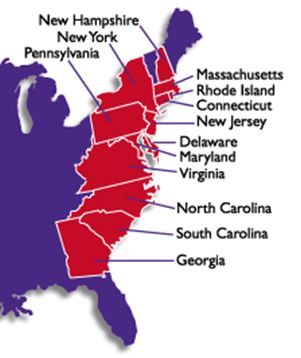
Initial Stages—Early 1700s

New England Colonies
►The American colonies were in a tragic spiritual decline and moral decadence ruled the day.
►The frontier areas had no churches and they were lawless.
►Colonists of mixed nationalities lacked unity and were divided by intense religious convictions.
►Perpetual war with indigenous people (American Indians) produced inhuman passions, removing moral convictions and restraints.
►A wild and adventurous spirit possessed the people as morals declined and religion decayed.
►Drunkenness, immorality, and every type of sin blossomed.
►The dream of a Christian utopia by the Puritans that arrived on the Mayflower (November 1620) and others arriving after them was disregarded by the second and third generation that followed.
►The “Age of Reason,” or “Enlightenment,” led churches into deism and Universalism, and the preaching of a “born-again” experience was rare. Many church members, and ministers, could not give evidence of a conversion experience.
►The Half-Way Covenant opened the door for unconverted people to become members of the church, and soon unconverted ministers filled pulpits across the land.
- Flagrant sins corrupted and weakened the churches.
- Christianity was in a very low state. Believers were generally dead, lifeless, careless, carnal, and secure.
- One man stated: “Christianity lay as it were dying, and ready to expire its last breath of life.”
- It appeared to be a hopeless situation.
Extraordinary Prayer
Though small and ineffective, the remnant within the Church was praying for God to save the souls of their neighbors.
What Happened
December 1734 – First Wave of Revival

Jonathan Edwards
Pastor of the Congregationalist Church
in Northampton, Mass.
►Jonathan Edwards, a Congregationalist pastor from Northampton, Massachusetts, began to preach the Gospel deliberately and powerfully in a series on ‘justification by faith alone.’
►In December 1734 six young people were converted. One was a young woman who was quaintly described as “one of the greatest company keepers in the whole town.” Her life was so radically changed that it became the talk of the town and the news of this evident act of God’s grace spread like wildfire.
►In the next six months 300 of the 1,100 population were converted. That’s more than 25% of the population in six months!
~~~~
Results
►There was scarcely a single person in the town of Northampton, Mass., either old or young, that was left unconcerned about the great things of the eternal world.
►The town seemed to be full of the presence of God; it never was so full of love and full of joy.
►It was a time of joy in families.
►The public assemblies were beautiful; the congregation was alive in God’s service, everyone earnestly attending public worship.
►The new converts were extremely zealous. They became bold in their evangelistic efforts and were overwhelmed with a compulsion to tell others the Good News.
►The preaching of the Good News brought a deep conviction of sin and of the peril of rebelling against God’s love.
1740 – 1742 – Second Wave of the Revival
►In New England alone 10% of the total population of 300,000 were added to the churches between 1740 and 1742.
► It is estimated that a further 30,000 souls were converted through the English evangelist George Whitefield.
►The English founder of the Methodist Church, John Wesley, made trips to America, and by the time of his death in 1791 there were 40,000 that made up the Methodist churches in America.
►150 new Congregational churches were established in twenty years.
►More than 100 towns had been blessed with revivals.
►Baptist churches multiplied. In the last half of the century the number of their churches grew from 9 to upwards of 400, with a total of 30,000 members.
►Similar growth was experienced in Presbyterian and other churches.
►Nine Christian universities were established in the colonies.
►Early missionary desire began to emerge, most notably in the ministry of David Brainerd among the Indians.
►The revival revolutionized the nation’s religious and moral character and determined the destiny of the nation.
Specifics About the Second Wave of Revival in Northampton, Massachusetts (1740-1742)
Jonathan Edwards, the pastor of the Congregational Church of Northampton, Massachusetts, reflected back on the revival in a letter to the Rev. Thomas Prince of Boston (dated December 12, 1743). In the letter he mentions the following:
►During the nine years since the beginning of the revival (early 1734), the zeal of the believers had declined tragically. The following things were noted:
- Prayer was consistent through the duration.
- A few were born-again during this time, but not like before.
- In the spring of 1740, the young people became more serious about the state of their souls.
►Mid-October 1740, George Whitefield came to Northampton and preached four sermons, as well as private times of sharing at the home of Jonathan Edwards. The result of this visit was:
- “The congregation was extraordinarily melted by every sermon; almost the whole assembly being in tears for a great part of sermon time.”
- There was a renewed zeal and hunger for the Word of God.
- Within four to six weeks there was a genuine reviving that returned to the believers.
- By mid December 1740 the young people and children were greatly impacted.
►May 1741: Following a sermon in a home, several believers were so overcome by the sense of the greatness and glory of divine things, and the infinite importance of things eternal that they were not able to conceal it. The affections of their minds overcame their physical strength and it had a very visible effect upon their bodies.
- After the sermon, the young people met in a separate room, discussing what had transpired. Through the discussion, they saw themselves in a new light, full of sin, and being distressed over their condition… “the whole room was full of nothing but outcries, faintings, and the like.”
- When others in the town heard about what had taken place, they “were overpowered in like manner.”
- These occurrences during meetings became common.
►Children were also greatly affected. The room where children were given counsel “was filled with cries; and when they were dismissed, they almost all of them went home crying aloud through the streets.”
►Summer 1741—young people, 16 to 26 years of age: Meetings with Jonathan Edwards and these young people resulted in the same contrition as was experienced with the children.
►August and September 1741 “were the most remarkable of any this year for appearances of conviction and conversion of sinners and great revivings” among Christians.
- “It was a very frequent thing to see a house full of out-cries, faintings, convulsions, and such like, both with distress, and also with admiration and joy. It was not the manner here to hold meetings all night, as in some places, nor was it common to continue them till very late in the night; but it was pretty often so, that there were some that were so affected, and their bodies so overcome, that they could not go home, but were obliged to stay all night where they were.”
►February 1742—Rev. Samuel Buell was invited to preach in Northampton. Some of the results were the rekindling of zeal among the believers, which during the month following September 1741 had began to wane.
- From Buell’s sermons the people were greatly impacted, with many crying out, and many staying after the service for many hours
- Many private meetings in homes were conducted by Buell. The entire time was reawakened with a zeal and passion for Christ
- “There were some instances of persons lying in a sort of trance, remaining perhaps for a whole twenty-four hours motionless, and with their senses locked up; but in the mean time under strong imaginations, as though they went to heaven and had there a vision of glorious and delightful objects.”
►March 16, 1742: Jonathan Edwards drew up a COVENANT for the entire congregation (those 14 years and above) to sign. Among other things the contract was a public commitment to live godly lives.
►Summer 1742: There seemed to be a diminishing of the revival. Though there were periodic movings of the Holy Spirit, the revival was declining.
Source
► Jonathan Edwards On Revival
► The Great Awakening by Thomas S. Kidd
► The Life if President Edwards (chapter 14) by Dwight Sereno
Return to List of Revival Stories
Chet & Phyllis Swearingen:
Office: (260) 920-8248
romans1015@outlook.com
Beautiful Feet
P.O. Box 915
Auburn, IN 46706

